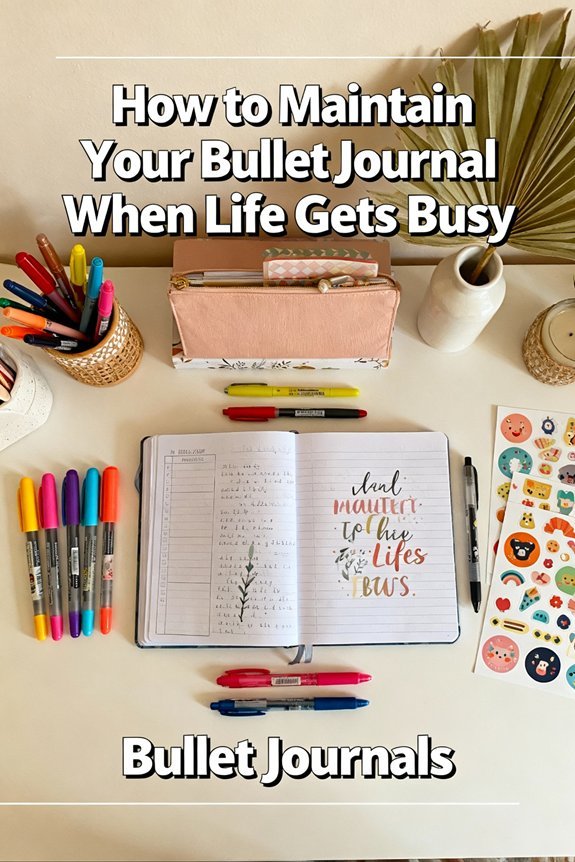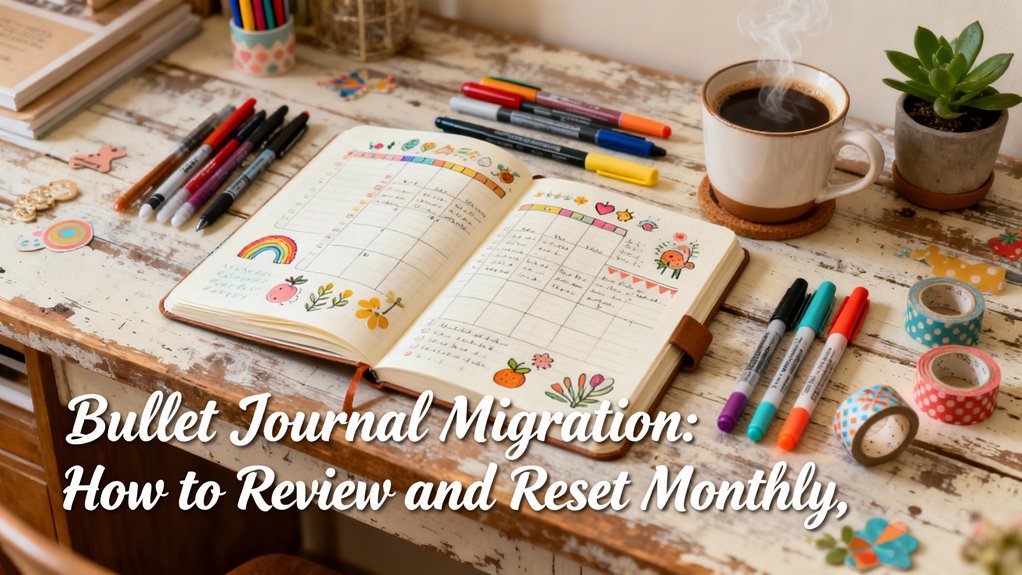When life gets overwhelming, strip your bullet journal down to function-only essentials: rapid logging with four basic symbols, a two-column crisis layout separating “Must Happen Today” from everything else, and three daily micro-planning sessions of five minutes each. Use flags instead of rewriting tasks, abandon decorative elements without guilt, and let your monthly log become your strategic command center. You'll find that minimalism actually strengthens your system, and the approaches that follow will show you exactly how to build this optimized framework into sustainable habits.
Key Takeaways
- Simplify layouts to essentials using only a black pen, basic symbols, and functional elements without decorative headers or color schemes.
- Use rapid logging with four core symbols (tasks, events, notes, priority) to capture information quickly without decision fatigue.
- Schedule three brief micro-planning sessions daily (morning, midday, evening) to review priorities and adjust plans flexibly.
- Create a crisis mode layout with two columns (“Must Happen Today” and “Everything Else”) for overwhelming periods.
- Transform monthly logs into strategic control panels to identify patterns, set goals, and maintain a scannable overview of priorities.
Strip Your Spreads Down to Bare Essentials

Your bullet journal loses its power when every spread becomes a multi-hour art project. When life accelerates, you'll need to prioritize function over aesthetics. Strip your layouts down to essential items only: rapid logging, key symbols, and basic tracking modules.
Minimal design isn't about sacrificing effectiveness—it's about amplifying it. Drop the elaborate headers, intricate doodling, and time-consuming color schemes. Instead, implement a simplified framework that captures what matters in minutes, not hours.
Simplicity amplifies effectiveness. Strip away decorative elements and build a framework that captures what matters in minutes, not hours.
Focus on systems that scale with your schedule. A simple three-line daily log outperforms an abandoned decorated spread every time. You're building a productivity tool, not a portfolio piece.
Test this approach: dedicate one week to bare-bones layouts using only black pen and essential tracking elements.
You'll discover that simplicity creates consistency, and consistency drives results. Your bullet journal becomes sustainable when it adapts to your reality rather than demanding unrealistic maintenance commitments.
Embrace the Power of Rapid Logging
Rapid logging converts chaotic thoughts into actionable clarity through four simple symbols: tasks (•), events (○), notes (—), and priority (*). This efficient system changes your bullet journal into a high-performance tool for time management, capturing information in seconds rather than minutes.
When life accelerates, you'll rely on these symbols to document everything without breaking your workflow. Capture quick notes during meetings, log tasks as they emerge, and mark priorities instantly. The beauty lies in the system's flexibility—you're not crafting elaborate entries; you're building a functional database of your commitments.
Resist the urge to expand beyond these core symbols. Additional markers create decision fatigue and slow your capture speed. Your bullet journal succeeds when it becomes second nature, requiring zero mental overhead to use.
During chaotic periods, this stripped-down approach guarantees you'll actually maintain your system. The symbols work because they're fast, intuitive, and eliminate the friction between thinking and doing.
This streamlined practice helps you slow down and clear mental clutter even when your schedule feels overwhelming, allowing you to reconnect with what actually requires your attention.
Schedule Micro-Planning Sessions Throughout Your Day

Three strategic pauses throughout your day—morning, midday, and evening—transform your bullet journal from a static list into a responsive command center.
These micro planning techniques anchor you when chaos threatens to derail your intentions.
Your morning session sets priorities. Spend five minutes reviewing your monthly spread and migrating essential tasks to today's log. This creates clarity before distractions accumulate.
At midday, reassess. You'll discover what's actually achievable versus what you'd hoped to accomplish. Adjust your daily planning strategies accordingly—migrate low-priority items and focus on what matters now.
Your evening review closes the loop. Document what you've completed, reflect on what shifted, and prepare tomorrow's foundation. This isn't about perfection; it's about continuous recalibration.
These fifteen cumulative minutes create momentum. You're not abandoning structure when life accelerates—you're building a flexible system that adapts with you.
Create a Crisis Mode Layout That Takes 60 Seconds
When everything collapses—deadlines converge, emergencies strike, or overwhelm threatens to paralyze you—a simplified layout becomes your lifeline.
When crisis hits and paralysis looms, your simplified journal layout becomes the anchor that keeps you functional.
Your crisis layout strips away decorative elements and complex tracking systems. Draw a single vertical line down your page, creating two columns. Label the left “Must Happen Today” and the right “Everything Else.” That's it. No time blocking, no elaborate spreads, no color coding.
This emergency system acknowledges reality: you're in survival mode, and your journal should reflect that. Quick adjustments matter more than perfection right now. You'll capture what's critical without the cognitive load of maintaining your usual structure.
Keep this template bookmarked or photographed on your phone. When chaos hits, flip to a blank page and recreate it in under sixty seconds.
Once stability returns, you'll migrate tasks back to your regular spreads. This isn't abandoning your system—it's adapting intelligently to preserve it.
Use Flags and Symbols to Replace Lengthy Migrations

Traditional migration wastes precious minutes rewriting complete tasks across multiple pages.
You'll optimize your workflow by implementing flagging strategies that mark tasks for movement without transcribing every detail.
Design a visual system using flags—small tabs, colored dots, or corner marks—to indicate where tasks belong. A red flag means “urgent rollover,” while a blue one signals “delegate this.” You're creating instant visual cues that eliminate decision fatigue.
Enhance your efficiency by assigning symbol meanings that communicate task status at a glance. Use an arrow (→) for migrated items, a star (★) for priority actions, and a circle (○) for items awaiting someone else's input. These shorthand notations replace lengthy explanations.
Reference your original task entry by noting page numbers alongside your symbols. You'll maintain context without duplicating information.
These time management techniques transform migration from tedious busywork into strategic planning that supports your most meaningful goals.
This approach changes migration from a tedious copying exercise into a quick marking process that takes seconds, not minutes.
Batch Similar Tasks in Your Collections
Your bullet journal becomes exponentially more functional when you group related tasks into dedicated collections rather than scattering them throughout daily logs. This approach alters task organization from reactive to strategic, enabling you to tackle similar work in focused batches.
Create targeted collections like “Calls to Make,” “Emails to Send,” or “Errands by Location.” When similar tasks cluster together, you'll eliminate the mental friction of constant context-switching. You're processing one type of work at a time, which dramatically increases collection efficiency and execution speed.
Design collections that align with your actual workflow patterns. If you handle client work differently than internal projects, separate them. If certain tasks require specific tools or mindsets, group them accordingly. This systematic batching doesn't just organize your tasks—it engineers your productivity by matching how you naturally work.
Review these collections weekly to maintain their relevance and prevent them from becoming cluttered repositories.
Let Go of Decorative Elements Without Guilt

You don't need elaborate spreads and color-coded headers to maintain an effective bullet journal—prioritize what works over what looks Instagram-worthy.
Minimalist layouts take seconds to set up and let you focus on actually using your system instead of decorating it.
If fancy elements drain your time or make you avoid your journal altogether, you're better off dropping them entirely.
Function Over Aesthetic Appeal
While Instagram-worthy spreads might capture thousands of likes, they're not what keeps your bullet journal functional when life gets hectic.
Prioritize purpose by stripping away minimal distractions that consume time without adding value. Your system needs efficient design that serves you, not the other way around.
Essential elements for functionality first:
- Simple layouts with clarity over complexity—black pen and basic headers work perfectly
- Essential tracking that captures what matters without elaborate templates
- Organized efficiently using quick symbols instead of time-intensive illustrations
Practical aesthetics emerge naturally when you focus on what works. Your bullet journal becomes more powerful through systems-focused thinking rather than decorative complexity.
This shift alters your journal from a creative project into a reliable tool that adapts instantly to changing demands while maintaining momentum.
Simple Layouts Save Time
When decorative elements start consuming more time than the planning itself, they've crossed from improvement to obstacle. You don't need elaborate borders or intricate headers to maintain an effective system. Simple designs—clean lines, basic dividers, and minimal formatting—accomplish the same organizational goals in a fraction of the time.
Strip your spreads down to their functional core. Replace time-intensive illustrations with quick sketches that convey information instantly. A simple box checks tasks just as effectively as an ornate checkbox. Your bullet journal exists to support your productivity, not showcase artistic skills.
Release the guilt around simplified pages. When life accelerates, your journal should adapt with you. The most sustainable system is one you'll actually maintain.
Embrace minimalism as a strategic choice, not a compromise.
Embrace Minimalist Bullet Journaling
Minimalist bullet journaling isn't about sacrificing beauty—it's about redirecting your energy toward function. When life accelerates, minimalist aesthetics become your strategic advantage. You'll complete your spreads in minutes rather than hours, maintaining consistency when it matters most.
Strip your practice down to essential tools that serve your system:
- Single black pen – Eliminates decision fatigue and creates clean, scannable pages
- Two signifiers maximum – Tasks and events only; complexity kills momentum
- White space as design – Empty margins improve readability and reduce visual noise
This approach alters your journal into a high-performance tool rather than an art project.
You're not abandoning creativity—you're channeling it into building systems that adapt to chaos. Function becomes your new aesthetic, and efficiency your most elegant design choice.
Leverage Your Monthly Log as Your Command Center

Your monthly log functions as the control panel for your entire bullet journal system. It's where scattered tasks, evolving priorities, and emerging insights converge into actionable intelligence.
Transform your monthly review into a strategic ritual. Scan your daily spreads, identify patterns in what you've actually accomplished versus what you planned, and extract lessons that'll refine your approach. This isn't busywork—it's systems optimization.
Use this space for goal setting that connects your daily actions to bigger outcomes. When you're drowning in commitments, your monthly log reveals what truly matters and what's just noise. It shows you where your energy's actually going.
Keep it scannable. Use symbols, color coding, or simple headers that let you absorb critical information in seconds. Your monthly spread should answer: What needs attention? What's complete? What's shifted?
This central dashboard keeps you adaptive when chaos strikes, ensuring nothing essential falls through the cracks.
Build Flexibility Into Your Tracking Systems
Because life refuses to follow your predetermined categories, your tracking systems need built-in adaptability from day one. Rigid structures crumble when unexpected priorities emerge, but flexible layouts evolve with your changing needs.
Design your trackers to accommodate reality's messiness. When your carefully planned habit grid becomes obsolete mid-month, you'll thank yourself for choosing adaptable tracking methods over picture-perfect spreads.
- Leave blank columns in your trackers for habits or metrics you'll discover matter only after you've started tracking—your future self will need that space when new patterns emerge.
- Use pencil for tracker labels during the first week, then commit with ink once you've confirmed what actually deserves your attention.
- Create modular mini-trackers that exist independently rather than sprawling across full spreads, allowing you to abandon what's not working without destroying entire pages.
Your journal should bend without breaking. That's not compromise—it's intelligent design.
Frequently Asked Questions
What if I Miss Several Days or Weeks in My Bullet Journal?
Don't stress—gaps happen! Skip the detailed bullet journal catch up and try a “brain dump” page instead.
List key events, feelings, or tasks you remember, then jump straight to today's date. This creative journaling tip keeps you moving forward without perfectionism paralysis.
You can also create a simple timeline or use symbols to mark significant moments. The system works *for* you, not against you.
Adapt, iterate, and keep going—that's innovation in action.
How Do I Restart My Bullet Journal After Abandoning It Completely?
Think of restarting like turning a fresh page—literally. You don't need to fill the gap or apologize to blank pages.
Simply date a new spread and begin your bullet journal setup from today. This clean slate approach alters creative journaling from a guilt-laden task into an adaptable system.
Focus forward, not backward. Create collections that matter now, establish realistic daily logs, and design trackers aligned with your current goals.
You're innovating your practice, not failing it.
Can I Maintain Multiple Bullet Journals for Different Life Areas When Busy?
You *can* maintain multiple journals, but it'll likely overwhelm you when busy.
Instead, innovate your life organization by creating dedicated sections within one journal—work, personal, wellness—using color-coding or tabs for quick navigation.
This organized system reduces decision fatigue and keeps everything centralized.
If you're determined to use separate journals, assign each a specific review day and keep one “master” index.
However, consolidation typically wins when time's tight, making your planning more efficient and sustainable.
Should I Buy a New Notebook if My Current One Feels Overwhelming?
Feeling trapped by cluttered pages? Don't buy a new notebook yet—your current one isn't the problem.
Instead, redesign your notebook organization by creating a fresh index and migration system. You'll discover creative bullet journal alternatives within your existing pages: dedicate new sections, use tabs, or implement color-coding.
This systematic approach respects your investment while building better habits. Remember, switching notebooks won't fix organizational issues; altering your structure will.
Start your reset today.
How Do I Handle Guilt About Incomplete Pages From Busier Months?
Practice self compassion by reframing incomplete pages as data points about your capacity, not failures.
Treat guilt management as a systems problem: add a simple “pause” symbol to sparse months, acknowledging life's natural rhythms.
You're building an adaptive tool, not a perfect artifact. Convert those pages into learning opportunities—what worked when time tightened?
This mindset shift turns your journal into an honest record of evolution, making it more valuable than any pristine spread.
Conclusion
Your bullet journal isn't a pristine garden demanding constant pruning—it's a working compass that guides you through storms. When life swirls into chaos, strip away the decorative vines and trust the root system you've built. Each rapid log is a breadcrumb back to clarity, each simplified spread a lighthouse beam cutting through fog. You're not abandoning your practice; you're honoring it by letting it bend without breaking. That's resilience in action.








